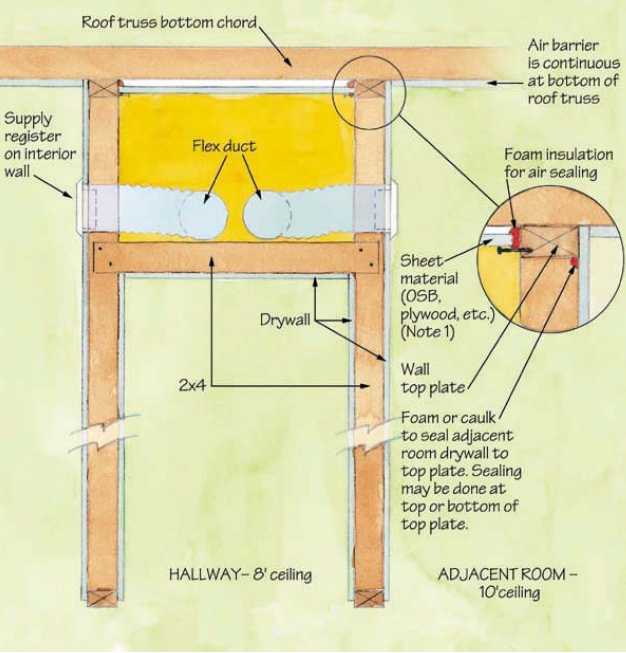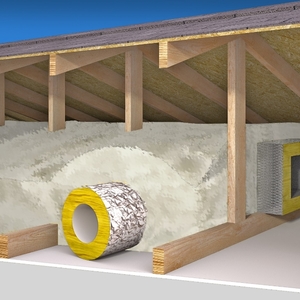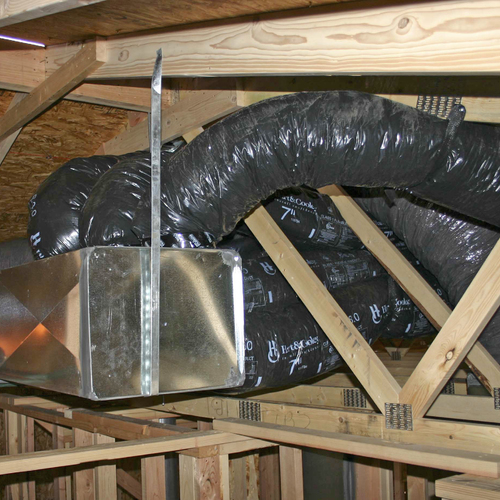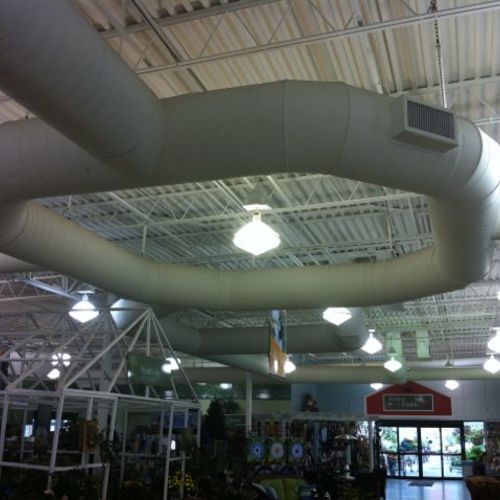
Image Credit: Image #1: California Energy Commission
If you live in New England, you know that furnaces are installed in basements. But any New Englander who moves to Oregon soon learns that furnaces are installed in garages. And anyone who retires to Texas discovers that furnaces are installed in unconditioned attics.
Of course, there are many other examples of similar regional differences in construction practices. But this is one regional difference that matters. New Englanders have it right: furnaces and ductwork belong inside a home’s conditioned space, not in the great outdoors.
If you build in a region where ducts are usually installed in unconditioned attics or ventilated crawl spaces, it’s time to get with the program and learn how to bring your ducts indoors, where they belong.
The problem isn’t trivial
Unconditioned attics, vented crawl spaces, and garages are cold in the winter and hot in the summer. Since most duct systems are leaky and poorly insulated, duct systems installed outside a home’s conditioned envelope waste tremendous amounts of energy.
According to Dave Roberts and Jon Winkler, engineers at the National Renewable Energy Laboratories, ducts in unconditioned attics waste about 20% of the output of a furnace or air conditioner. These researchers report that during peak conditions, the losses are even greater. Roberts and Winkler wrote that in Houston, Phoenix, and Las Vegas, “The average DSE [distribution system efficiency] for the three locations on the design day, which would be considered the day of the season when cooling demand is highest, is 72%. This means that on the hottest day of the summer, 28% of the air-conditioner output is ultimately lost.”
These calculations assume that attic duct connections are all intact. However, as any home inspector knows, attic ducts are often crushed, ripped, or completely disconnected. Since homeowners rarely visit all the nooks and crannies…
Weekly Newsletter
Get building science and energy efficiency advice, plus special offers, in your inbox.

This article is only available to GBA Prime Members
Sign up for a free trial and get instant access to this article as well as GBA’s complete library of premium articles and construction details.
Start Free TrialAlready a member? Log in















8 Comments
Reponse to James
James,
Thanks for your feedback.
My article mentions most of your points, including the drawbacks of any system that requires two visits by the drywall contractor, and the fact that duct soffits are easy to install anywhere in a home with 9-foot ceilings.
I'm glad to hear that your HVAC contractors do quality work in crawl spaces.
I disagree with one of your points, however: "If the ductwork is a first-class sealed installation it would not be a problem to omit the air-seal above." A leaky soffit may not reduce the performance of the HVAC system -- assuming the ducts are sealed perfectly -- but a leaky soffit will still degrade the performance of the home's thermal envelope.
Good post
This is an important reminder about the significance of strategic planning for distribution ductwork. I have a concern though about the various modified truss options shown here - creating a proper air seal above the ductwork will require two visits by the sheetrock crew, before and after HVAC rough-in, and I fear many contractors will not bother. If the ductwork is a first-class sealed installation it would not be a problem to omit the air-seal above, but as that requires exacting workmanship and good supervision it's not exactly a fool-proof strategy. And if you were to be going to that trouble wouldn't it be simpler just to run the ducts through the attic and heap plenty of insulation on top?
I'd also point out that trussed joists are not necessary to use the space between floors for ductwork if a home is thoughtfully designed. In two-story homes we commonly use 9' as the ceiling height in the first floor main rooms on the S side and use a dropped ceiling through ancillary spaces: mud room, bathroom, office etc arranged along the length of the N side. Then we have plenty of room to run a rigid E-W box lateral and bring flex duct up into the standard 2 x 10 joist depth to distribute N & S as needed. This is of course an extended form of the hallway detail shown above: hallways seldom run the full length of the house, but the lateral needs to do so. In a two-story home this solution is neat, tidy, presents no air barrier issues, and the ceiling height change can be used to accommodate a dropped beam where needed for structural support and add architectural definition in open plan areas.
Regarding crawl spaces: yes we do a lot of retrofit work where cramped working conditions are an impediment to first-class workmanship, but in new construction we can normally manage a mechanical area in the crawl space which has good access and is at least 40" high, and often much higher. Our HVAC techs experience little difficulty achieving a good standard of work in these spaces. And as return air filters are normally located in the conditioned space above, routine maintenance access by the homeowner is not necessary.
Sorry Martin
Somehow I missed your section on dropped soffits. Clearly I need to read more carefully before rushing to post. Need more coffee.
Regarding leaky soffits - wouldn't the air barrier be continuous at the ceiling below the ducts?
Response to James
Q. "Wouldn't the air barrier be continuous at the ceiling below the ducts?"
A. Well, that depends on two factors: whether the builder even knows where his air barrier is, and (assuming he knows where it is) where he plans to put it.
I certainly don't recommend that any builder plan to install his air barrier at the bottom of a duct soffit. That's done in far too many cases, and the result is that the ducts are no longer indoors -- they are partially outdoors.
My recommendation is that the air barrier be continuous with the top of the soffit, not the bottom of the soffit.
Cross purposes
I was thinking of the ceiling below the modified trusses, not below the dropped soffits where I entirely agree the air barrier belongs at the ceiling plane. In two-story construction a first floor ceiling chase can deliver both up and down, if needed, without introducing any air barrier complications. In single-story construction I try to avoid dropped soffits though for this very reason. If the ductwork absolutely has to go overhead, I'd sooner use a standard truss, allowing a simpler airtight sheetrock installation, and then ensure that the ductwork installation is well sealed to the air barrier at the register and riser penetrations and then well covered with insulation. I'd trust our HVAC techs to do a good job on a demanding installation, the sheetrock crews not so much.
Make sure the aesthetics are right
Martin,
I bought a two story house with ducting in soffits on the ceiling of the lower floor (daylight basement in Oregon), with a High-eff heat pump in a mechanical closet. I love the efficiency and simple design of the short branches within the conditioned space. What I did not like was the dated, clunky look.
During our remodel of the basement, I worked the layout so the ducting is basically invisible. Along one main run, I thickened up the entire wall with built-in book cases under the soffit. On the other run, which was just hanging from the ceiling, dividing a large bonus room, I put end walls on it to make it a thick wall with a large pass-through, again with built-ins. In the bedrooms we had the single run soffits, which I built out into full tray ceilings.
The point of my response: with a bit of thoughtful design, the best ducting options can fit into almost any house without poor aesthetics.
Furnace location
You say "It’s no longer acceptable to locate a furnace or air handler in the garage or an unconditioned attic." Why is that?
Response to Ben McCann
Ben,
Perhaps that sentence could have been better phrased. In reality, it has never been a good idea to locate a furnace or air handler in a garage or an unconditioned attic. The only difference between 20 years ago and today is that most builders should know better by now.
In most areas of the country, installing a furnace or air handler in a garage or an unconditioned attic is still legal. Just because the practice isn't forbidden by most building codes, however, doesn't mean it's a good idea.
The reason that building scientists call this practice unacceptable is because of the energy losses associated with the practice. During the winter, a furnace or air handler located in an unconditioned attic or garage loses tremendous amounts of wasted heat; during the summer, the heat flows the other way. Heat from a hot attic raises the temperature of the cool air in the air handler. Moreover, almost all ducts and plenums leak, and this duct leakage compounds the problem.
There is a further danger when a furnace or air handler is located in a garage: leaks in the supply plenum and supply duct pull contaminated garage air (with a mixture of car exhaust and fumes from paint cans and pesticide containers) into the house.
Log in or become a member to post a comment.
Sign up Log in